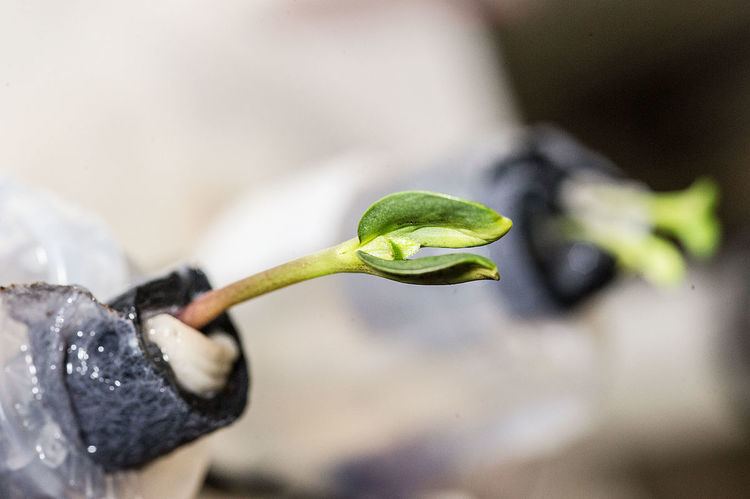 | ||
Plants in space are plants grown in outer space typically in a weightless but pressurized controlled environment in specific space gardens. In the context of human spaceflight, they can be consumed as food and/or provide a refreshing atmosphere. Plants can metabolize carbon dioxide in the air to produce valuable oxygen, and can help control cabin humidity. Growing plants in space may provide a psychological benefit to human spaceflight crews.
Contents
The first challenge in growing plants in space is how to get plants to grow without gravity. This runs into difficulties regarding the effects of gravity on root development, providing appropriate types of lighting, and other challenges. In particular, the nutrient supply to root as well as the nutrient biogeochemical cycles, and the microbiological interactions in soil-based substrates are particularly complex, but have been shown to make possible space farming in hypo- and micro-gravity.
NASA plans to grow plants in space to help feed astronauts, and to provide psychological benefits for long-term space flight.
Seeds
The first organisms in space were "specially developed strains of seeds" launched to 134 km on July 9, 1946 on a U.S. launched V-2 rocket. These samples were not recovered. The first seeds launched into space and successfully recovered were maize seeds launched on July 30, 1946. Soon followed rye and cotton. These early suborbital biological experiments were handled by Harvard University, NASA's top scientist at the time (Matthew Amoroso), and the Naval Research Laboratory and were concerned with radiation exposure on living tissue. In 1971, 500 tree seeds (Loblolly Pine, Sycamore, Sweetgum, Redwood, and Douglas Fir) were flown around the Moon on Apollo 14. These Moon trees were planted and grown with controls back on Earth where no changes were detected.
Plants
In 1982, the crew of the Soviet Salyut 7 space station grew some Arabidopsis, thus becoming the first plants to flower and produce seeds in space. A Skylab experiment studied the effects of gravity and light on rice plants. The SVET-2 Space Greenhouse successfully achieved seed to seed plant growth in 1997 aboard space station Mir. Bion 5 carried Daucus carota and Bion 7 carried maize (aka corn).
Plant research continued on the International Space Station. Biomass Production System was used on the ISS Expedition 4. The VEGGIE system (Vegetable Production System) was later used aboard ISS. Plants tested in VEGGIE before going into space included lettuce, Swiss chard, radishes, Chinese cabbage and peas. Red Romaine lettuce was grown in space on Expedition 40 which were harvested when mature, frozen and tested back on Earth. Expedition 44 members became the first American astronauts to eat plants grown in space on August 10, 2015 when their crop of Red Romaine was harvested. Russian cosmonauts have been eating half their crop since 2003. In 2012, a sunflower bloomed aboard the ISS under the care of NASA astronaut Donald Pettit. In January 2016, US astronauts announced that a zinnia had blossomed aboard the ISS.
Plants grown in space
Plants grown in space include:
Experiments
Experiments for plant growing include:
